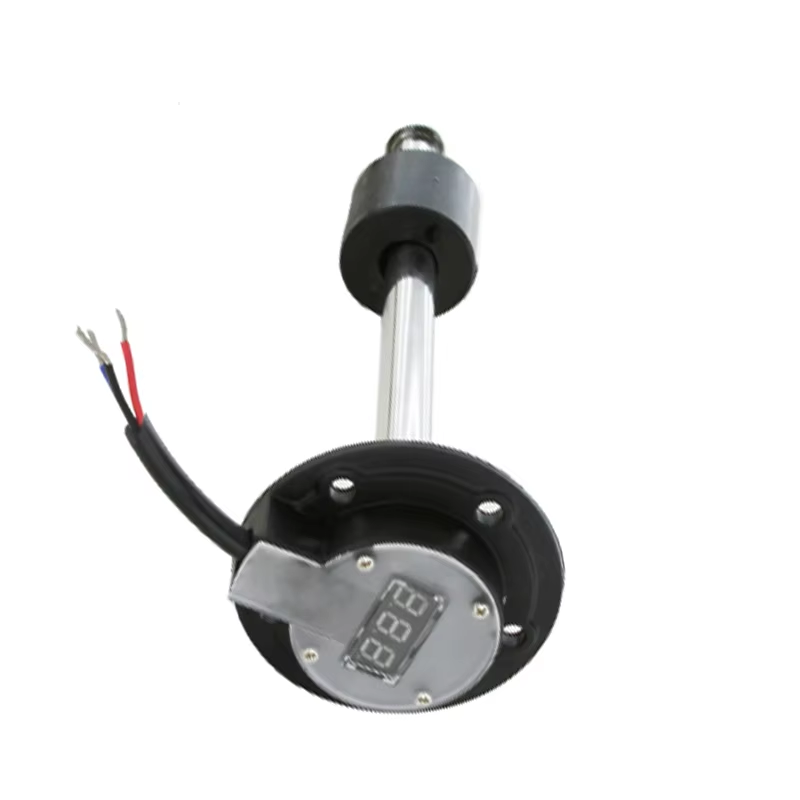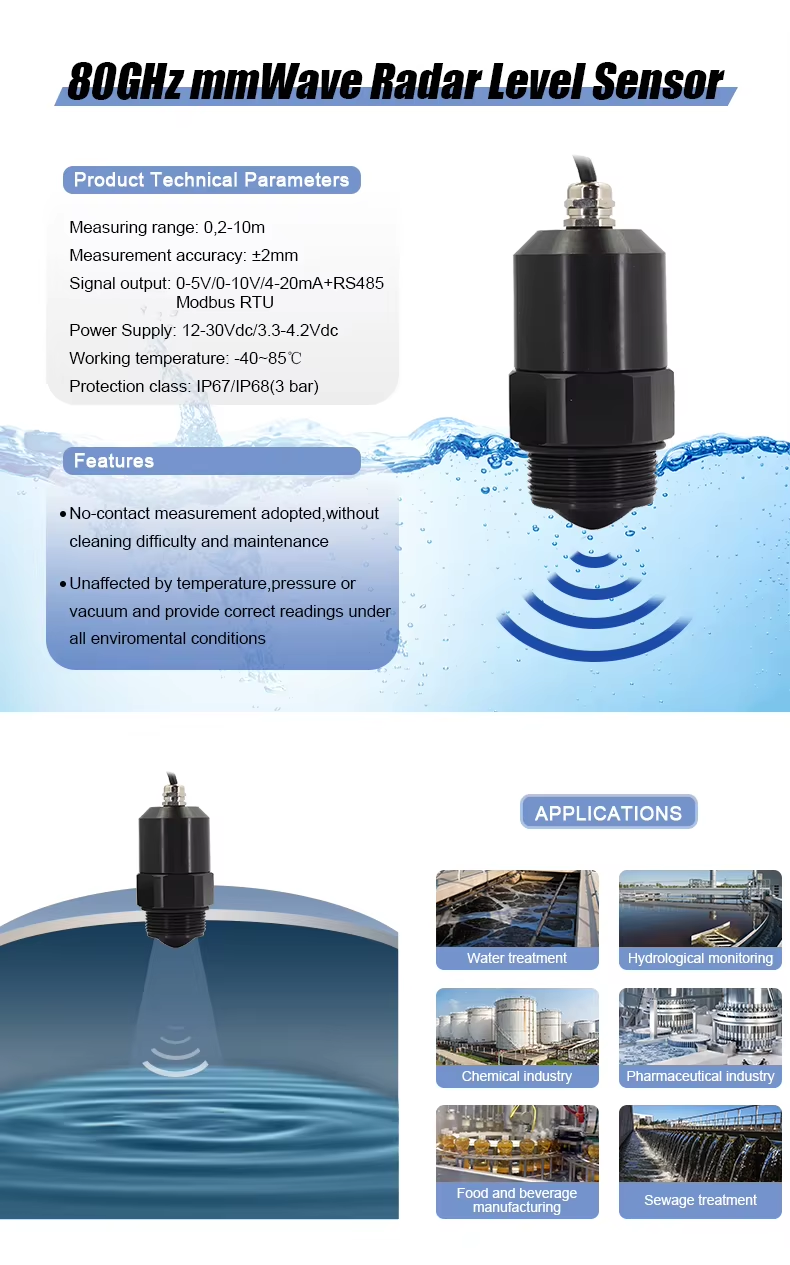Liquid level sensor is a common sensor to measure the position of liquid level, it is the height of the bit into the form of electrical signal output.In recent years, with the continuous development of electronic technology and automation, liquid level measurement and control technology has improved greatly.The production of daily chemicals, food and beverage, pharmaceutical and other industries, are inseparable from the monitoring of liquid level, the importance of the liquid level sensor is becoming more and more prominent, and even directly affect the quality of the product.
Level Sensor Definition
A level sensor is a pressure sensor that measures liquid level.It is divided into contact and non-contact.
Types of Liquid Level Sensors
1, Float Level Sensors
It consists of a magnetic float, a measuring conduit, a signaling unit, an electronic unit, a junction box and mounting parts.Generally the specific gravity of the magnetic float is less than 0.5, it can float on the liquid surface and move up and down along the measuring conduit.The conduit is equipped with a measuring element, which can convert the measured level signal into a resistance signal proportional to the level change under the effect of external magnetism, and convert the electronic unit into 4-20ma or other electronic standard signal output.

2, Float Level Sensor
Float Level Sensor is a magnetic float to float, float level sensor is the use of tiny metal film strain sensing technology to measure the liquid level, boundary level or density.
3, Hydrostatic Level Sensor
Hydrostatic Level Sensor is the use of explosion-proof flow meter liquid static pressure measurement principle.General selection of silicon pressure sensor will measure the pressure converted to electrical signals, and then amplified by the amplifier circuit and compensation circuit compensation, and finally to 4 ~ 20ma or 0 ~ 10ma current output.
Level Sensor Working Principle
Hydrostatic Measurement Principle: When the level transmitter is put into a certain depth in the measured liquid, the pressure on the liquid surface facing the sensor is given by the formula: Ρ = ρ .g.H + Po Eq:
P : Pressure on the liquid surface facing the transmitter
ρ : Density of the measured liquid
g : Local gravitational acceleration
Po : Atmospheric pressure on the liquid surface
H : Depth of liquid input to the transmitter
At the same time, the pressure of the liquid is introduced into the positive pressure chamber of the sensor through the air-conducting stainless steel, and then the atmospheric pressure Po on the liquid surface is connected to the negative pressure chamber of the sensor to offset the Po on the back of the sensor, so that the sensor measures the pressure: ρ .g.H, obviously , by measuring the pressure P, the liquid level depth can be obtained.
Level Sensor Features
1, High precision, good stability, strong anti-interference function.
2, Level sensor adopts three-level lightning protection plan, good lightning resistance.
3, Fullness, zero level temporary stability up to 0.1% FS / year.
4, Solid-state structure, no moving parts, high reliability, long service life, the existence of reverse maintenance, current-limiting maintenance circuit, in the installation of the positive and negative poles reversed will not destroy the transmitter
5, Convenient device, simple structure, economic and durable.
6, Level sensor suitable for multi-point pressure parameters network collection, bus support 255 sets of equipment, can be at the same time: 4-20mA output and RS485 communication function, the output current discrimination rate is better than 3uA.

Common level measurement methods
Due to the wide range of applications of liquid level sensors, different detection methods have their advantages and disadvantages, here we come to understand the common ways of liquid level measurement.
1, Float detection of the way for the most simple, the oldest detection method, the price is relatively cheap.Mainly through the float up and down to detect changes in the liquid level, its mechanical detection, detection accuracy is easily affected by buoyancy, repeatability is poor, different liquids need to be recalibrated.Not applicable to viscous or impurity-containing liquids, easily caused by the float clogging, at the same time, does not meet the application requirements of the food hygiene industry.
2, Capacitance measurement capacitance measurement mainly through the detection of changes in capacitance value due to changes in the height of the liquid or bulk material to measure the height of the material level.It has a variety of types, there can be output analog capacitance level meter, liquid level capacitive proximity switch, capacitive proximity switch can be installed on the side of the container for non-contact detection.When the choice must be noted that the capacitance sensor is susceptible to different container materials and solution properties.
3, Static pressure This measurement method uses a pressure sensor installed at the bottom to calculate the liquid level by detecting the liquid pressure at the bottom and converting it to calculate the liquid level height, with the reference value of the liquid pressure at the bottom being the atmospheric pressure connected to the top or a known air pressure.The detection method requires the use of high-precision, flush-type pressure sensors, while the conversion process needs to be constantly calibrated.
4, Photoelectric refractive measurement The detection method through the sensor internal light source, the light source through the transparent resin total reflection to the sensor receiver, but when encountered in the liquid surface, part of the light will be refracted to the liquid, so that the sensor detects the total reflection back to the decrease in the amount of light to monitor the liquid level.This detection method is cheap and easy to install and commission, but it can only be applied to transparent liquids and only outputs switching signals.
5. Tuning fork vibration measurement The tuning fork measurement is only a switching output and cannot be used for continuous monitoring of liquid height.The principle is: when the liquid or bulk material filled with two vibrating forks, the resonance frequency changes, relying on the detection of frequency changes and send a switch signal.It can be used for high viscosity liquid or solid bulk material height monitoring, mainly for overflow alarm, low level alarm, etc., does not provide analog output, in addition, most cases need to be mounted on the side of the container openings.
6, Ultrasonic measurement due to its principle for the detection of ultrasonic transmission and reflection of the time difference to calculate the height of the liquid level, it is susceptible to ultrasonic propagation of energy loss.It also has easy to install, flexibility and high characteristics, usually can be installed in high places for non-contact measurement.However, when used in environments containing vapors, powder layers, etc., the detection distance will be significantly shortened, and it is not recommended to be used in wave-absorbing environments, such as foam.
7. Microwave principle measurement Its name has a variety of different names in the industry, it has the benefits of laser measurement, such as: easy to install, calibration, good flexibility, etc., in addition to its more superior laser detection, such as no need to repeat the calibration and multifunctional output, etc., it is suitable for a variety of foam-containing level detection, not affected by the color of the liquid, and can even be applied to highly viscous liquids, by the external environment is relatively small interference, but its measurement height is generally less than 6 meters.

Difference between liquid level sensor and liquid level switch
Many people can't tell the difference between liquid level sensor and liquid level switch, and even think that they are the same kind of instrument.In fact, there is a big difference between them.The liquid level sensor does not necessarily display the liquid level, but outputs the liquid level in the form of an electrical signal.
Liquid level controller is based on the signal output of the liquid level sensor to open the water discharge or water inlet valve to keep the water level constant a controller.The role of the liquid level sensor is to send out electrical signals, if coupled with the reading of electrical signals and display devices is the electronic level meter, if coupled with the reading of electrical signals and processing devices is the liquid level controller.
Simply put, the following is the case:
Liquid level switch is a switch on the container, when the liquid level reaches the action, to control a signal switch.
Liquid level sensor level can also have the role of the switch, but to be more complex than it can continuously display the state of the liquid level.

